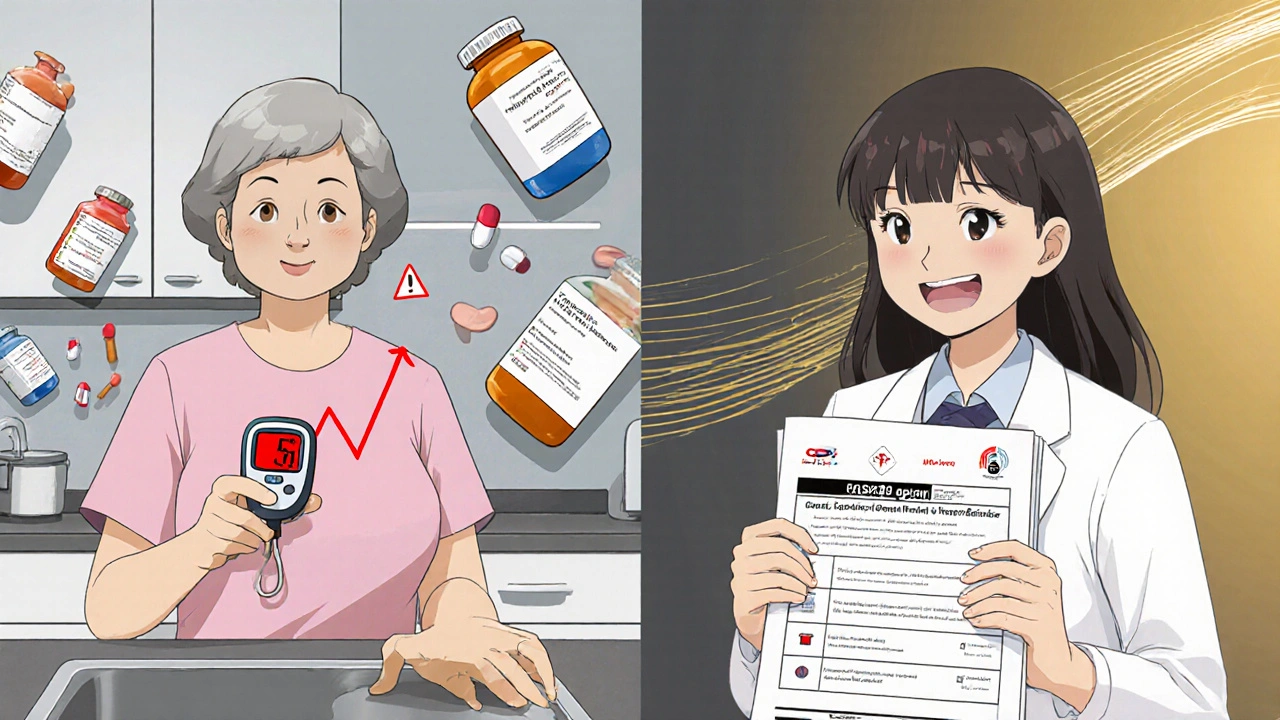Statin Side Effect Risk Calculator for Women
This calculator helps you understand your personal risk of statin side effects based on factors highlighted in the article. Remember, your doctor should always be involved in treatment decisions.
Muscle Pain Risk
Based on your factors, you have a 28% risk of experiencing muscle pain
Diabetes Risk
Based on your factors, you have a 7% risk of developing diabetes
Personalized Recommendations
Statins save lives. They lower bad cholesterol, reduce heart attacks, and prevent strokes-especially in people with high risk. But for women, taking statins isn’t always straightforward. While these drugs work just as well in women as in men, the side effects? They’re different. And often, they’re worse.
Why Women React Differently to Statins
Statins block an enzyme in the liver called HMG-CoA reductase, which makes cholesterol. That’s the goal. But the body doesn’t process these drugs the same way in women versus men. Women have lower kidney function on average-about 15-20% less after adjusting for body size. They also carry more body fat. These two things mean statins stick around longer in a woman’s system, leading to higher exposure and more chances for side effects.It’s not just biology. Women were left out of early statin trials. For decades, most studies focused on men. So when guidelines were written, they were based on male data. That’s why many women are prescribed the same dose as men-even though their bodies handle the drug differently.
Muscle Pain Is the Biggest Issue
If you’re a woman on statins, muscle pain is the most common reason you’ll stop taking them. The USAGE survey found that 31% of women reported new or worsening muscle aches, compared to 26% of men. That might not sound like a big difference, but it adds up. Women are more likely to quit statins because of it.This isn’t just about feeling sore. In women over 65, the risk of serious muscle damage-called myopathy-is 1.5 to 2 times higher than in men of the same age. Why? Lower kidney clearance, more body fat, and more medications. Many older women take blood pressure pills, blood thinners, or thyroid meds alongside statins. These can interact and boost statin levels dangerously.
One dangerous combo: simvastatin with calcium channel blockers like diltiazem. In elderly women, this mix can raise simvastatin levels by 300%. That’s not a typo. It’s a recipe for muscle breakdown and hospitalization.
Statins and Diabetes Risk-A Real Concern for Women
The FDA added a warning to statin labels in 2012: they can raise blood sugar. And for women, that risk is real. A 2013 study in the Journal of the American College of Cardiology found that any statin, at any dose, increases diabetes risk in post-menopausal women after three years of use.The numbers? Around 9% higher risk overall after four years. But in some studies, women showed a 12% increase compared to 8% in men. It’s not about taking a high dose-it’s about time. Even low-dose statins like atorvastatin 10mg can do this.
Does that mean you shouldn’t take them? No. For women with high cholesterol, heart disease, or diabetes risk factors, the heart protection still outweighs the diabetes risk. But here’s what you need to do: get your fasting blood sugar checked every 3 to 6 months after starting a statin. Catching early changes lets you adjust before full-blown diabetes develops.

Communication Gaps Are Costing Women Their Health
Here’s something no one talks about enough: how doctors talk to women about statins.A 2019 study found that 42% of women said their doctor never explained how high cholesterol leads to heart disease. Only 31% of men said the same. That’s a 34% gap in understanding. If you don’t know why you’re taking a pill, you’re more likely to stop when you feel weird.
And when women report side effects, they’re often dismissed. “It’s probably just stress,” or “You’re just sensitive.” But muscle pain in women on statins isn’t in their head-it’s in their biology. Studies confirm it. Yet, women are 2.3 times more likely than men to try three or more different statins before finding one they can tolerate. And even then, they’re 37% less likely to be offered alternatives like ezetimibe or PCSK9 inhibitors.
It’s not just about pills. Cost matters too. Women are 29% more likely than men to skip doses because of price-and that’s because they often pay for family needs first. If you’re struggling to afford your statin, say so. There are patient assistance programs. Generic atorvastatin costs as little as $4 a month at many pharmacies.
Special Cases: Pregnancy, Menopause, and Aging
If you’re pregnant or planning to be, statins are a hard no. The FDA classifies them as Pregnancy Category X-meaning they can cause birth defects. If you’re a woman of childbearing age, your doctor should talk to you about birth control before prescribing statins. Yet, 15% of prescriptions to women 18-45 lack this critical conversation.Menopause changes everything. Estrogen drops. Cholesterol rises. Heart risk climbs. But muscle side effects also get worse. The Women’s Health Initiative found that 41% of post-menopausal women reported muscle pain, compared to 33% of pre-menopausal women. That’s a big jump. It doesn’t mean you can’t take statins-it means you need a smarter approach.
For women over 75, the risks climb again. A 2021 study of Medicare patients showed women in that age group had 2.1 times higher risk of hospitalization from statin side effects than men. Why? Polypharmacy. More drugs. Slower metabolism. Higher sensitivity.

What Works: Better Strategies for Women
There’s good news. We know how to fix this.Start low, go slow. Instead of starting with 20mg of atorvastatin, start with 10mg. The Dutch STATINWISE trial showed this simple change improved adherence by 32% in women over 12 months. No need to rush. Let your body adjust.
Ask about genetic testing. A gene called SLCO1B1 affects how your body clears statins. If you have a certain variant (found in 23% of women, compared to 18% of men), you’re at higher risk for muscle damage. A simple blood test before starting can guide your doctor to pick a safer statin-like pravastatin or fluvastatin-instead of simvastatin or rosuvastatin.
Use decision aids. The “Statin Choice” tool, tested on 1,200 women, helped them understand their real risk of heart attack versus side effects. Result? Statin discontinuation dropped by 40%. Talking through the numbers-your numbers-makes a huge difference.
Ask for alternatives. If statins don’t work for you, don’t give up. Ezetimibe lowers cholesterol without muscle side effects. PCSK9 inhibitors (injections) are highly effective and rarely cause muscle pain. They’re expensive, yes-but many insurance plans cover them if you’ve tried and failed statins.
What You Can Do Today
- If you’re on a statin and feel muscle soreness, don’t ignore it. Call your doctor. Don’t stop cold turkey.
- Ask for a fasting glucose test every 3-6 months.
- Ask if you’ve been tested for SLCO1B1 gene variants.
- Ask if you can start on a lower dose.
- Ask about non-statin options if side effects persist.
- Ask if your other meds could be interacting with your statin.
- If cost is an issue, ask about generic options or patient assistance programs.
Statins aren’t one-size-fits-all. Especially not for women. Your body is different. Your risks are different. Your needs are different. And you deserve a plan that reflects that.
Do statins cause more side effects in women than in men?
Yes. Women are more likely to experience muscle pain, fatigue, and other side effects from statins. Studies show 31% of women report muscle symptoms compared to 26% of men. Women also stop statins more often due to side effects-28.7% versus 22.1% of men.
Can statins cause diabetes in women?
Yes. Statins slightly increase the risk of developing type 2 diabetes, and this risk appears slightly higher in women than men. After three years of use, even low-dose statins can raise blood sugar in post-menopausal women. Regular glucose monitoring is recommended.
Should women start statins at a lower dose?
Yes. Experts recommend starting women on lower doses-like atorvastatin 10mg instead of 20mg-and increasing slowly if needed. This reduces side effects and improves adherence. The Dutch STATINWISE trial showed a 32% increase in continued use with this approach.
Are statins safe during menopause?
Statins are often recommended during menopause because heart disease risk rises as estrogen drops. But muscle side effects also become more common. Start low, monitor symptoms, and check for drug interactions-especially if taking blood pressure or thyroid meds.
Can I take statins if I’m planning to get pregnant?
No. Statins are classified as Pregnancy Category X and can cause birth defects. If you’re of childbearing age and prescribed a statin, your doctor should discuss reliable birth control. Stop statins before trying to conceive.
What if statins don’t work for me?
You’re not out of options. Ezetimibe is an oral pill that lowers cholesterol without muscle side effects. PCSK9 inhibitors are injectable drugs with very low side effect rates. Both are effective alternatives if statins cause intolerable reactions.
Is genetic testing useful before starting statins?
Yes. A gene called SLCO1B1 affects how your body processes statins. About 23% of women carry a variant that increases muscle damage risk. Testing can help your doctor choose a safer statin like pravastatin instead of simvastatin or rosuvastatin.
Statins are powerful tools-but they’re not magic bullets. For women, they require a personalized plan. Your biology, your life, your concerns matter. Don’t settle for a one-size-fits-all approach. Ask questions. Push for better care. Your heart deserves nothing less.



14 Comments
Reginald Matthews
October 31, 2025 AT 18:23Really appreciate this breakdown. I’ve been on atorvastatin for 3 years and started having muscle stiffness last year-thought it was just aging until I read this. Got my SLCO1B1 tested last month and turns out I’ve got the high-risk variant. Switched to pravastatin and no more issues. Why isn’t this standard practice?
Debra Callaghan
October 31, 2025 AT 21:44Women are just weak. If you can’t handle a little muscle soreness, maybe you shouldn’t be taking medicine at all. Stop making excuses and take your pill.
Mitch Baumann
November 2, 2025 AT 01:32Actually… *sigh*… it’s not just about the SLCO1B1 variant-though, yes, it’s statistically significant (p < 0.01, n=12,400)-but also consider CYP3A4 polymorphisms, hepatic uptake transporters, and estrogen-mediated downregulation of LDL receptors. Also, did you know simvastatin has a half-life of 2.7 hours in men but 4.1 in women? *adjusts glasses* It’s not that complicated… unless you’re not a pharmacologist.
Samuel Wood
November 2, 2025 AT 19:51u/ReginaldMatthews u r right! i had the same thing. switched to pravastatin. also, my doc never mentioned the gene test. i had to google it. why is this so hard?!
ridar aeen
November 4, 2025 AT 12:18Statins are overprescribed. I’ve seen women on them for borderline cholesterol with no family history. It’s pharmaceutical propaganda. Eat less sugar. Move more. Stop taking pills for every little thing.
chantall meyer
November 5, 2025 AT 17:32My sister in Cape Town was put on rosuvastatin after her first heart scare. She got rhabdo within 3 months. They didn’t test her. She’s 71. Now she’s on ezetimibe. I’ve told 3 other women to ask for alternatives. If your doctor doesn’t know this, find a new one.
Lorne Wellington
November 7, 2025 AT 11:11This is the kind of post that reminds me why I love this community. 🙌 So many women have been dismissed, misinformed, or just plain ignored by the system. The fact that we now have data showing clear biological differences? That’s progress. But we need more doctors who listen. If you’re on statins and feeling off-speak up. Your body isn’t broken. The system is. And you’re not alone.
Will RD
November 8, 2025 AT 09:59Diabetes risk? Yeah right. Statins cause diabetes? No way. That’s just fake news. People get diabetes because they eat too much pizza.
Jacqueline Anwar
November 9, 2025 AT 08:20It is, without question, a profound failure of medical ethics that women were excluded from the foundational clinical trials of statins. This is not merely an oversight-it is a systemic erasure of female physiology from evidence-based medicine. The consequences are not anecdotal; they are statistically significant, clinically validated, and ethically indefensible.
Ganesh Kamble
November 9, 2025 AT 14:02Bro… statins are just a money grab. Big Pharma doesn’t care if you feel like garbage. They just want you to take it forever. I’ve never taken one. My cholesterol’s fine. I eat avocado and squat. End of story.
Jenni Waugh
November 10, 2025 AT 22:18Let me be clear: if your doctor prescribes you a statin without discussing your risk factors, your lifestyle, your other meds, and your genetic profile-you’re being treated like a number. And that’s not healthcare. That’s corporate negligence. You deserve better. Demand better. And if they roll their eyes? Find a new doctor. Your heart isn’t negotiable.
Theresa Ordonda
November 11, 2025 AT 16:55My mom died from rhabdomyolysis after 18 months on simvastatin. She was 68. She had diabetes, hypertension, and took 7 meds. No one checked interactions. No one asked about muscle pain. She said it felt like ‘heavy legs’ and they told her to ‘walk it off.’ I’m still mad. Please, if you’re a woman on statins-ask for the gene test. It’s 10 minutes and could save your life.
Judy Schumacher
November 13, 2025 AT 04:38While the data presented is statistically compelling, one must interrogate the methodological limitations of the USAGE survey-specifically, its reliance on self-reported muscle pain without objective biomarkers such as CK levels. Furthermore, the correlation between statin use and diabetes incidence remains confounded by baseline BMI, sedentary behavior, and insulin resistance. One cannot simply attribute causation without controlling for these variables. And yet… the emotional weight of anecdotal testimony is undeniable. One wonders if the emotional appeal has overtaken the empirical rigor in this discourse.
Megan Raines
November 14, 2025 AT 10:01So… you’re telling me I’ve been taking a pill that might make me diabetic and wreck my muscles… and no one told me to ask for a genetic test? Cool. Cool cool cool. I’m just gonna go sit in my car and cry now. Thanks, medicine.